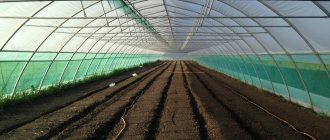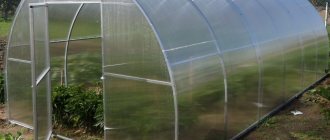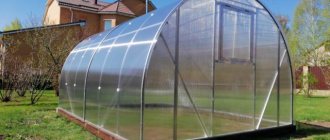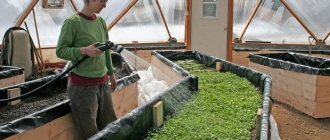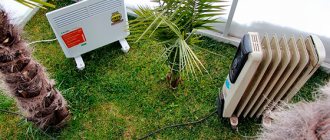Greenhouse / Heating
Thermostat
These days there are a large number of thermostats on the sales market. These are very convenient devices that are also used when working in a greenhouse. They will help maintain the temperature of the air and soil in the room. Which will save the owner from unnecessary work.
- 1 Types of thermostats 1.1 Separation by type
- 1.2 Selecting a thermostat
- 2.1 What is it intended for?
Why is thermoregulation needed in a greenhouse?
In greenhouses, it is very important to maintain the air temperature, as well as the soil layer, at a certain level, regardless of what vegetable crop is grown in them.
By ensuring round-the-clock temperature control, taking into account the type of plant grown in this device, a fairly high yield can be obtained.
Otherwise , with sudden changes in air temperature, freezing, and overheating of the soil layer, there is no point in using greenhouses.
After all, a decrease in temperature causes the greenery to begin to absorb all the necessary nutrients from the soil much worse, and its increase leads to the fact that the plant either begins to grow rapidly or almost completely burns out.
By regulating the temperature in the greenhouse and constantly monitoring various parameters inside the greenhouse, maximum development of the root system of a particular vegetable crop and their proper growth are achieved. In addition, the fruits are formed correctly and their ripening time is reduced.
Each type of plant requires maintaining a certain air and soil temperature. In most cases, these indicators differ by a couple of degrees.
On average, the temperature in greenhouses is set at +20+22°C. However, when choosing the most optimal mode, you should definitely take into account the characteristics of the plant crop grown in this building.
Thermostat for heated floors, incubators, electronic thermostat with temperature sensor
Timur Dakaev
writes: does it accurately show the temperature or are there errors?
Sasha Popov
writes: what camera did you use?
Alex K.
writes: Greetings. Does this thermostat have memory? Those. If the electricity goes out and then turns on, will the temperature we set be reset or will the setting remain?
Frank Kauperwood
writes: It’s bad that he constantly twitches, the light bulbs will burn out often often
Chirchik Chirchik
writes: HOW MUCH DOES THIS REGULATOR COST?
How timely your article appeared. Just today in our forum of amateur gardeners, we discussed how to automatically ventilate polycarbonate greenhouses. After all, everything is good in them, but in the heat the problem is that it is not always possible to open, because many people are working.
Now I’ll send the link to my gardeners, let them study it too)))
On a note! Such electronic thermostats are becoming increasingly popular because they have the ability to sense the temperature at any point inside the greenhouse, and the monitoring sensor can be placed between the plants, in the soil substrate, or suspended near the roof. Such a wide range of placement allows the thermostat to have accurate data on the state of the internal environment of the greenhouse.
The ideal mechanism would be one based on a converted factory relay.
The work is carried out on the principle of an electromagnet, where the armature is drawn into a coil. The switch (2A, 220V) controls the electromagnetic starter to supply power to the heating devices.
How to regulate?
Today, there are special devices that are designed to automatically regulate the temperature inside the greenhouse.
But this equipment sometimes turns out to be too expensive to export, especially if there is more than one greenhouse.
In such cases, you can use cheaper and fairly simple methods that can effectively reduce or increase the temperature. In addition, it is worth noting that some of them are more effective compared to modern technical devices.
In order to quickly raise the air temperature in a building, you must use one of the following methods:
- Covering the greenhouse with an additional layer of plastic film in order to create an air gap that does not react to various environmental factors.
- Inside, a so-called secondary greenhouse is made - an additional cover is attached to a previously prepared structure, so that it is located directly above the surface of the plants.
- Thorough mulching of the soil layer makes it possible to attract heat to the plants using polyethylene film or black spunbond.
There are also methods that allow, if necessary, to lower the temperature level inside greenhouses. The most common ones include:
- Greenhouses should not be made too long.
- There should be free access of air flows from the environment through the gables.
- The structure is treated with a special chalk solution.
- Watering the growing vegetable crops with a sufficient amount of water in the morning.
If automatic devices are used, then you can use such effective methods as correct control of the system intended for heating the greenhouse, as well as opening the vents after the thermostat has given the appropriate command.
Boiler control algorithm
- When power is supplied to the device, the controller polls the sensors and reads information from the real-time clock. The controller compares the current time with those set for day and night modes and selects the appropriate settings for the operation of the thermostats.
After about 5 seconds, the device is activated and begins to control the boiler.
- If the temperature from the Pol-1, Pol-2 or Office sensors becomes lower than the set one, then the pump and heater are switched on and voltage is applied to the corresponding actuator for supplying coolant to this circuit. When the temperature rises above the set value by the hysteresis value, the heater turns off, the pump remains in operation for 30 seconds to ensure cooling of the heating element to a safe temperature. To ensure water flow through the boiler circuit, the coolant supply remains open to this circuit while the pump is operating. If the operation of the boiler is necessary for another circuit, then the coolant is switched off to the already unnecessary circuit immediately.
Greenhouse temperature controller options
Nowadays, several types of thermostats :
- Electronic.
- Sensory.
- Mechanical.
They differ from each other in design features and the principle of operation of the mechanism.
mechanical thermostat for a greenhouse is a device whose task is to regulate the operation of climate control equipment in order to maintain certain temperature parameters.
It can be used not only for heating, but also for cooling the greenhouse space.
Its peculiarity is that a separate device is completely independent. In most cases, the device is manufactured in the form of external electrical installation equipment mounted directly in the greenhouse itself.
On electronic thermostats, the role of a sensor is played by a thermistor. The main advantage of devices of this type is the accuracy of temperature control. After all, they are able to react to even the most minor changes.
Thus, you can significantly save on the cost of electricity, which is used to heat the greenhouse.
Using touch thermostats, you can set a specific operating time for the heating system. In addition, at different times you can set different, most suitable temperatures. Such devices, as a rule, are programmed for a fairly long period of time - it is possible to set the desired mode for a week, and in some models for longer.
And here is a video about a homemade thermostat for a greenhouse (temperature adjustment by opening the windows).
Installation of temperature control devices - mechanics and electronics
It is ideal when thermostats complement the work of transom thermal drives: in winter they turn the heating off and on, and in summer the microclimate is controlled by opening and closing the vents. Thus, a summer resident can devote much less time to his greenhouse without fear for his harvest.
Pneumatic thermostat – removal of excess heat
The pneumatic device, the action of which is based on the ability of hot air to expand, is easy to assemble and at the same time allows you to solve the problem of thermoregulation for a long time. For its installation the following elements are required:
- 2 tin paint cans with a capacity of 5–7 liters (with lids);
- several tubes from medical IVs;
- children's inflatable ball with a coverage of about 300 mm;
- thin plywood with a width of at least 300 mm;
- metal strips (strips) of arbitrary size;
- 3 copper tubes 50 mm long.
Schematic diagram of the pneumatic regulator
Assembling the thermal drive involves performing a few simple steps:
- Seal the cans by soldering or pouring epoxy resin.
- Drill one hole to fit the copper tubes in one container and two in the other.
- Insert the tubes into the holes and seal the joints.
- Make a box measuring 300x300 mm from plywood. Leave it open on both sides.
- Cut the plywood plate to the dimensions that best fit the cavity of the box.
- Insert the plate inside the box and secure it with hinges.
- Attach the open part of the box to the window.
- Make a movable lever from two metal strips, one arm of which is rigidly attached to the window, and the other to the movable plate of the plywood box.
- Close the window and check the position of the plate - its angle of inclination relative to the walls of the box should be 45 degrees.
- Hang tin containers under the roof and connect them with tubes from the droppers, while the length of the outgoing tube should cover the distance from the cans to the box.
You need to close the entire system into a single mechanism in cool weather or in the evening. To do this, you need to put the ball in the box and inflate it exactly until the moment when, with further air injection, it begins to open the window.
After this, you should tightly connect the end of the outgoing tube with the ball and check the operation of the device when it warms up.
Pneumatic system in a different version
Thermostat made from a gas shock absorber
By slightly modifying the pneumatic shock absorber from any passenger car (these are usually installed on hoods or rear doors), you can get a device that can automatically open a transom or window, thereby eliminating excess thermal energy.
The spare part does not have to be new - it is enough that there is pressure in it. You also need to stock up on a brake hose and an empty car fire extinguisher in advance.
You can mount these parts into a single device as follows:
- Without breaking the tightness of the pneumatic cylinder, cut off the spherical part of its shank, leaving the maximum length.
- From the side of the formed end, drill a hole with a diameter of 2–3 mm to bleed air from the cylinder cavity.
- Cut a thread on the shank (its pitch depends on the size of the thread on the existing brake hose).
- Use a fire extinguisher (or a 3-liter car universal joint) to build an oil tank with a connecting hole for a hose.
- Pour oil into the shock absorber and into the reservoir, then connect them with a hose.
After installing the thermostatic system, test its functionality by temporarily increasing the heating power.
How to modify a shock absorber for a pneumatic system
Homemade pneumatic regulator in a greenhouse
Thermal drive from a gas shock absorber - option 1
Quite often, automatic equipment for greenhouse ventilation is assembled literally from nothing. The operating principle of this option is the use of a substance that reacts to cooling or heating by contracting or expanding. In this case, car oil. To build a thermal drive you will need:
- car shock absorber piston or car gas spring;
- metal pipe for oil;
- two taps.
- A shock absorber rod must be attached to the window that the device will close and open.
- Then prepare a pipe for machine oil. To do this, attach an oil fill valve to it on one side. On the other side there is the same valve for draining oil and adjusting pressure.
- It is necessary to cut off the bottom of the gas spring and tightly connect it to the oil pipe. The thermal drive is ready.
DIY thermostat
You can make the device in question with your own hands - for this it is recommended to remake a simple dial thermometer.
Necessary materials
To make a thermostat you will need the following materials:
- 9 W light bulb;
- thin tin;
- phototransistor;
- glue;
- corner for obstructing the direction of the arrow;
- lens;
- photocell wire;
- an automobile hydraulic cylinder or a piece of sheet metal, zinc, plastic, polycarbonate;
- ball chamber made of plastisol;
- toggle switch;
- neon lamp.
To make a hydraulic drive you will need the following materials:
- cylinder 300 mm long and 40 mm in diameter;
- hydraulic tank;
- brake hose with M10 thread, pitch 1.25;
- M-10 bolt 50–60 mm long;
- screw;
- wooden stick;
- metal plug;
- 2 circles of penoplex with a diameter of 40 and 38 mm;
- air chamber from the ball;
- spindle oil.
In order to design a regulator yourself, you must follow this algorithm:
- Disassemble the thermometer without damage.
- In the area of the desired temperature range in the scale, carefully drill a hole with a diameter of 2.5 mm.
- Opposite it, cut a corner with a 2.8 mm hole from thin sheet metal.
- Place the phototransistor in the corner socket and glue it with glue.
- Place the corner to prevent the arrow from moving under the hole and secure it.
- Place a 9 W light bulb on the opposite side of the thermometer.
- For a better reaction to the temperature indicator, you need to install a lens, placing it between the light bulb and the scale.
- Route the photocell wire through the central hole on the thermometer scale.
- Drill a hole for the light bulb wires in the housing.
- Insert a tourniquet into the vinyl chloride casing and secure it.
- Assemble a photo relay with a GT 109 transistor and a voltage stabilizer using a standard circuit.
- Place all elements on the base of the relay mechanism.
- On the outside of the common body, place a toggle switch and a neon lamp to signal the heating.
Hydraulic drive for thermoregulation, diagram
The operating principle of the hydraulic drive is to perform reciprocating movements that do not require the use of electricity.
- Take a car hydraulic cylinder or build this element yourself using a sheet made from the materials listed above.
- The bottom of the structure must be sealed using a circle cut out of polystyrene foam of the appropriate diameter.
- Make a circular hole in the center of the plug.
- Next, you need to make a rod and piston using a wooden stick and a second such circle, but with a diameter 2 mm smaller so that the piston can slide freely along the entire length of the cylinder.
- Take the chamber with air inside, attach a hose to it and place it inside the device, threading it through the hole in the plug.
- Attach the rod to the piston and insert it into the cylinder so that it presses against the air chamber.
- Cool the oil to +14. 15°C.
- Pour the cooled liquid into the hydraulic tank, progressively moving the rod: this way you will bleed this system.
- After filling the container with liquid, screw on the cap, tightening it with a wrench. The rod must be retracted.
- Then add oil to the top through the hole in the plug.
- Screw it in with a bolt and secure it with a nut. This manipulation should be continued until the rod begins to extend.
Thermal drive from cylinders and a rubber ball
This original ventilation device is very easy to make with your own hands. And for this you will need:
- wooden box with lid;
- regular inflatable ball;
- two cylinders;
- hose;
- board.
- Attach a hose with a length equal to the height of the greenhouse to the communicating metal cylinders.
- Place the other end of the hose onto the nipple of the inflatable ball.
- Place the deflated ball in the box so that when it inflates, it pushes out the lid.
- Nail a board to the lid of the box and connect it to the window.
- You need to install the cylinders under the ceiling of the greenhouse, and the ball in the box below, under the transom. As soon as the cylinders heat up, the ball will inflate and open the window.
In order to choose a particular device, you need to consider its pros and cons. Thermal actuators made from bottles and balls are less reliable, because everything depends on tightness.
Devices made from shock absorbers are more durable, but they are also more difficult to make. All of the described DIY thermostats will help you ventilate the greenhouse in your absence.

